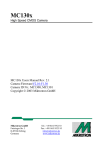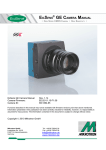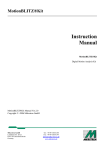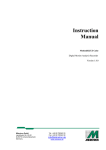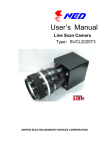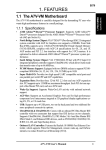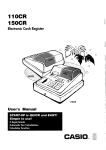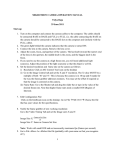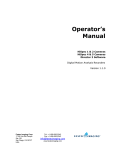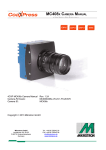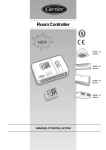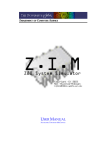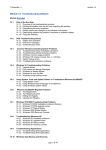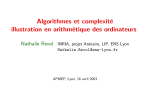Download MC13xx User Manual
Transcript
MC13xx High Speed CMOS Camera MC13xx Users Manual Rev. 1.08 Camera-Firmware: V1.10-F1.31 Kamera ID Nr.: MC1302, MC1303, MC1310, MC1311 Copyright 2003 Miktrotron GmbH Mikrotron GmbH Freisinger Str. 3 D-85386 Eching Germany Tel.: +49 8165 9523 0 Fax: +49 8165 9523 95 [email protected] www.mikrotron.de General MC13xx Users Manual Rev. 1.08 Table of contents 1 General..........................................................................................................................4 1.1 1.2 1.3 1.4 1.5 1.6 1.7 2 For customers in the U.S.A. .................................................................................................................................... 4 For customers in Canada ......................................................................................................................................... 4 Pour utilisateurs au Canada ..................................................................................................................................... 4 Life Support Applications ....................................................................................................................................... 4 Declaration of conformity ....................................................................................................................................... 5 Warranty Note......................................................................................................................................................... 6 Remarks, Warnings ................................................................................................................................................. 6 Introduction.............................................. General MC13xx Users Manual Rev. 1.08 6.8.6 Asynchronous exposure, shutter control by pulse width .................................................................................. 20 6.8.7 Asynchronous exposure, shutter control by timer ............................................................................................ 21 6.9 Firmware ............................................................................................................................................................... 22 6.9.1 Update Firmware .............................................................................................................................................. 22 6.9.2 Reset and configuration of the internal FPGA.................................................................................................. 22 6.10 Horizontal pixelbinning......................................................................................................................................... 22 6.11 Vertical pixelbinning............................................................................................................................................. 22 6.12 Digital shading correction ..................................................................................................................................... 23 6.13 Digital gain............................................................................................................................................................ 23 6.14 External clock input .............................................................................................................................................. 23 6.15 Polarity of EXP-signal .......................................................................................................................................... 23 6.16 Test image ............................................................................................................................................................. 24 6.17 Image counter........................................................................................................................................................ 24 6.18 ImageBLITZ shutter release, MC1310/11 only ................................................................................................. 24 6.18.1 ImageBLITZ® processing ........................................................................................................................... 25 6.18.2 ImageBLITZ® programming ...................................................................................................................... 25 6.18.3 ImageBLITZ® registers .............................................................................................................................. 27 6.18.4 ImageBLITZ® setup.................................................................................................................................... 28 7 MC13xx configuration tool ........................................................................................29 7.1 7.2 8 Basic Configuration............................................................................................................................................... 29 ImageBLITZ® Configuration ............................................................................................................................... 30 Mechanical dimensions ..............................................................................................31 8.1 Camera body ......................................................................................................................................................... 31 8.1.1 Dimensioned drawing, side view of MC13xx .................................................................................................. 31 8.1.2 Dimensioned drawing, front view of MC13xx................................................................................................. 32 8.1.3 Dimensioned drawing, rear view of MC13xx .................................................................................................. 32 8.2 Lens adjustment .................................................................................................................................................... 33 8.2.1 Adjustable lens adapter..................................................................................................................................... 33 8.2.2 Lens selection ................................................................................................................................................... 33 9 Technical Data ............................................................................................................34 9.1 9.2 9.3 9.3.1 9.3.2 9.4 9.4.1 9.4.2 9.4.3 9.5 9.5.1 9.5.2 9.5.3 9.6 9.7 9.7.1 9.7.2 9.7.3 9.7.4 Spectral response................................................................................................................................................... 35 Sensitive area of a pixel ........................................................................................................................................ 36 Connector pinning ................................................................................................................................................. 37 Camera Link® Connector, MDR-26 ................................................................................................................ 37 Circular power connector, 6-pin ....................................................................................................................... 38 Camera Link® Bit Assignments ........................................................................................................................... 39 Base Camera Link® 2*8/10 - Bit Assignment ................................................................................................. 39 Full Camera Link® 8*8-Bit Assignment.......................................................................................................... 40 10*8-Bit Assignment........................................................................................................................................ 41 Frequency selection............................................................................................................................................... 42 Frequencies for video data width 2*8/10 - Bit, Base Camera Link®............................................................... 42 Frequencies for video data width 8*8 - Bit, Full Camera Link® ..................................................................... 46 Frequencies for video data width 10*8 – Bit.................................................................................................... 46 Programming sequence, factory profile f3 ............................................................................................................ 48 Timing................................................................................................................................................................... 49 Pixel clock ........................................................................................................................................................ 49 Line Valid (LVAL, DVAL).............................................................................................................................. 49 Frame Valid (FVAL)........................................................................................................................................ 50 Exposure Signal (EXP)..................................................................................................................................... 50 3 General MC13xx Users Manual Rev. 1.08 1 General 1.1 For customers in the U.S.A. This equipment has been tested and found to comply with the limits for a Class A digital device, pursuant to Part 15 of the FCC Rules. These limits are designed to provide reasonable protection against harmful interference when the equipment is operated in a commercial environment. This equipment generates, uses, and can radiate radio frequency energy and, if not installed and used in accordance with the instruction manual, may cause harmful interference to radio communications. Operation of this equipment in a residential area is likely to cause harmful interference in which case the user will be required to correct the interference at his own expense. You are cautioned that any changes or modifications not expressly approved in this manual could void your authority to operate this equipment. The shielded interface cable recommended in this manual must be used with this equipment in order to comply with the limits for a computing device pursuant to Subpart J of Part 15 of FCC Rules. 1.2 For customers in Canada This apparatus complies with the Class A limits for radio noise emissions set out in Radio Interference Regulations. 1.3 Pour utilisateurs au Canada Cet appareil est conforme aux normes Classe A pour bruits radioélectriques, spécifiées dans le Règlement sur le brouillage radioélectrique. 1.4 Life Support Applications These products are not designed for use in life support appliances, devices, or systems where malfunction of these products can reasonably be expected to result in personal injury. Mikrotron customers using or selling these products for use in such applications do so at their own risk and agree to fully indemnify Mikrotron for any damages resulting from such improper use or sale. 4 General MC13xx Users Manual Rev. 1.08 1.5 Declaration of conformity Manufacturer: Mikrotron GmbH Address: Freisingerstr. 3 85386 Eching Deutschland Product: camera camera camera camera MC1302 MC1303 MC1310 MC1311 The dedicated products conform to the requirements of the Council Directives 89/336/EWG for the approximation of the laws of the Member States relating to electromagnetic consistency. The following standards were consulted for the conformity testing with regard to electromagnetic consistency. EC regulation Description EN 61000-6-3 EN 61000-6-1 Electromagnetic compatibility Immunity Eching, June 06th. 2003 Mikrotron GmbH Dipl.-Ing. Bernhard Mindermann President of Mikrotron 5 General MC13xx Users Manual Rev. 1.08 1.6 Warranty Note Do not open the body of the camera. The warranty becomes void if the body is opened. 1.7 Remarks, Warnings This document contains important remarks and warnings. See the corresponding symbols: L Important remark * Attention, Warning 6 Introduction MC13xx Users Manual Rev. 1.08 2 Introduction The CMOS high speed camera MC13xx is a high resolution camera with 1280•1024 pixel. Benefits of CMOS technology are high speed, random access to pixels with free programmability and low power. The camera uses industry-standard C-Mount lenses. The sensor diagonal is 1,25“ with square pixels measuring 12µm. Free programmability means that the user is free to define the region of interest by size and position and the speed of data output. The frame rate can be slected between 25 fps and several thousand fps depending on resolution and video datawidth. With a resolution of 1280 x 1024 pixel, 500 fps (MC131x) can be output via the “full Camera Link® parameter sets are called: profiles and stored in non volatile memory. 2.1 Top level specifications • • • • • • • • • • • • • • high resolution: 1.280•1.024 pixel CMOS sensor with 1300 A/D converters up to 1.024 gray levels up to 100 full frames/s for MC1302/03 up to 500 full frames/s for MC1310/11 arbitrary region of interest high sensitivity 12µm square pixels electronic “Freeze Frame” shutter low blooming programmable via serial link patented ImageBLITZ® image trigger (MC1310/11) asynchronous trigger download customer specific FPGA preprocessing firmware small, compact housing wide power supply range 2.2 Electronic „Freeze Frame“ Shutter Preceding exposure, the contents of all light sensitive elements is cleared. When exposure terminates, accumulated charge is transferred to an analog memory associated which each pixel. It stays there until it is read out (and discharged) by the A/D conversion cycle. As all light sensitive elements are exposed at the same time, even fast moving objects are captured without geometric distortion. 7 Introduction MC13xx Users Manual Rev. 1.08 2.3 Differences between the camera types The CMOS cameras MC1302/10 are monochrome, the MC1303/11 are a color cameras equipped with a Bayer filter. MC13xx is being delivered in four different versions, color / monochrome, with or without Full Camera Link® interface. As reference the phased-out MC1301 is also shown. Features Data width (bits) Type MC1301 8 MC1302 10 MC1303 10 MC1310 10 MC1311 10 Color/ Mono M M C M C Full Camera Link® + + Framerate@ Base Camera 1280 x 1024 Link® + 100fps + 100fps + 100fps + 500fps + 500fps Table 2.3-1 ImageBLITZ® + + + Housing depth mm 55 48 48 48 48 2.4 Using the camera There are no serviceable parts inside the camera.. The camera may not be opened, otherwise guarantee is lost. Use dry, soft lens-cleaning tissue for cleaning lenses and, if necessary, the sensors window. 8 Hardware MC13xx Users Manual Rev. 1.08 3 Hardware 3.1 Camera Link® Interface Camera Link® is designed for digital cameras in machine vision applications. A “Full Camera Link®” interface can transfer up to 64 bits of data at a rate of >528 Mbytes/sec. 3.1.1 Serial interface The communication via the serial interface is incorporated in the “Base Camera Link® interface. A description of the connector pinning is in chapter 9.2. 3.2 Power supply The camera needs a DC supply voltage between 8 … 35 V at a power consumption of 6,0 Watt max.. See also Connector pinning . 3.3 Status LED A dual colour LED on the camera backplane shows the operating condition of the MC13xx. LED orange... The MC13xx is configuring the internal FPGA. No other activity is possible. LED green... The MC13xx is fully operational. LED off... If LED is off, despite the camera is powered, the FPGA configuration data is reloaded via the serial interface and stored in internal EEPROM. No other activity is possible. 9 Getting started MC13xx Users Manual Rev. 1.08 4 Getting started Before starting to operate the camera, make sure that the following equipment is available: • • • • Camera MC13xx C-Mount Lens Mikrotron Support CD Image processing system, e.g.: PC, frame grabber and Software L The frame grabber must have a Base- or Full Camera Link® Interface. Additional items: • 1 or 2 standard Camera Link® cables • 1 Power supply 12VDC, 0.5A min • 1 power cable L To specify cables see chapter Connector pinning. 4.1 First steps 1. 2. 3. 4. 5. Switch off the image processing system Connect Camera Link® cable between camera and frame grabber. Connect power cable. Unscrew dust protection cover, screw in lens. Switch on the image processing system and camera power supply 10 Initial setup MC13xx Users Manual Rev. 1.08 5 Initial setup The MC13xx is delivered with initial parameters and therefore does not need to be configured via the serial link. 5.1 Serial number and firmware revision Serial number and firmware revision is provided in MC13xx non volatile memory. Use :v command (Read serial number and firmware revision) to read serial number and firmware revision. The serial number is also marked on the type plate of the camera. 5.2 PowerUpProfile The PowerUpProfile is the contents of all camera registers to be loaded from non-volatile memory after power up. 5.3 Camera Profile The actual set of parameters is called Camera Profile. All changes of parameters by the serial link is reflected in the Camera Profile. On command the Camera Profile is saved to 8 user profiles or one PowerUpProfile. It is loaded from 8 user profiles or 8 factory profiles or the PowerUpProfile. The camera profile is volatile and must be stored to the PowerUpProfile to be reactivated on next poer up. 5.4 Factory profile The factory profile can be read but not written by the user. 5.5 User profiles The user can store up to eight PowerUpProfiles in non volatile memory. All load or write commands exchange data between the PowerUpProfile and one of the four user profiles. Profil-Nr. Video data width 0 1 2 3 4 5 6 7 2x8 2x8 2x8 2x8 2x10 2x10 8x8 8x8 resolution / Pixel 100 x 100 240 x 240 640 x 480 1280 x 1024 640 x 480 1280 x 1024 1280 x 1024 640 x 480 Table 5-1 Image frequency /fps 4.852 1.011 202 47 150 33 120 954 11 Configuration MC13xx Users Manual Rev. 1.08 6 Configuration The MC13xx has 15 FPGA registers, r1..rfh , each 10 bit wide, eight D/A registers, a1..a8, 8-bit wide, and one clock select register, 4 bit wide. The contents of all the above registers is called a profile. There is space in non volatile memory for 17 profiles: one PowerUpProfile, 8 user profiles and 8 factory profiles. Any change of a specific register through the serial interface is immediately processed and written to the volatile part of the memory and gets lost when power goes down. A command must be used to store the actual setting in non volatile memory. After power-up the PowerUpProfile is loaded from the nonvolatile to the volatile part of the memory. A load or write command exchanges data between the PowerUpProfile and one of the eight user profiles. The eight factory profiles can be read but not be written by any command. All values are given in hexadecimal notation, e.g.: 0xff or 0ffh = 255. 6.1 Commands ASCII strings are used to change camera parameters. All commands start with a colon, followed by one selection character and a value in hexadecimal notation with two or three ASCII characters. After a command has been recognized, processing is immediate, for all commands but the save type commands (:px). These need a EEPROM write time of app 1ms. An answer is provided with read type commans (:v, :w, :W) or, if the command “command acknowledge flag” is set, after processing of each command an ACK or NAK character. Processing of wrong command is stopped immediately on recognizing the error. A new command must start with a colon. 12 Configuration 6.1.1 MC13xx Users Manual Rev. 1.08 Table of commands Syntax Range :a<n><xx> <n> = 1...8 <xx> = 0...ffh :A<n> <n> = „y“,“Y“,“n“,“N“ :b<n> <n> = 0...4 :c -- Answer -- --- :e... :f<n> -<n> = 0...7 --- :g<n> <n> = 0...7 -- :p<n> <n> = 0...7 -- :r<n> :s<n> <n> = 1...fh <n> = 0…fh --- :S :t<n><m> 6 Byte Code <n> = 00..7fh <m> = 00..ffh <xx> = 0…7fh <yy> =1…80 (hex) <xxx>=0..3ffh <yyy>=1..3ffh --- :x<xxyy> :y<xxxyyy > :v -- :w -- :W -- --- Description Set one of eight analog voltages for the sensor En- or disable a command acknowledge or not acknowledge (ACK or NAK) Select baud rate: 0=9600 Bd (default setting), 1=19.2 kBd, 2=38.4 kBd, 3=56.8 kBd, 4=115.2 kBd RESET and new Initialization of the camera, new load of PowerUpProfile. Duration: some seconds Transmit & save a new FPGA configuration Reload one of eight, factory defined and calibrated profiles to PowerUpProfile. Reload one of eight user profiles to PowerUpProfile Save PowerUpProfile to one of eight user profiles, allow app. 1ms save time. Write a FPGA - register Select sensor and pixel clock from a table with 16 entries. Program sensor and pixel clock directly. Short setting of X- position in units of 10 pixel and Y-position in units of 4 lines. Short setting of horizontal image size and position (xx = horizontal position, yy = horizontal width (unit: 10 pixel)) Short setting of Image size and position in Y – direction xxx = Y-position, yyy= vertical width (unit: 1 line) Read serial number (#), microcontroller - version (V...) and FPGA - version (F...). #12345V1.10F1.29 camera Read actual PowerUpProfile, data output in hex profile: 44 bytes in hex Camera Read actual PowerUpProfile, data output in profile: 44 ASCII bytes in ASCII 6.2 Read serial number and firmware revision The serial number and the firmware revision can be read with the :v command. Command: Response(e.g.): :v #01234-V1.10-F1.29↵ Serial number of the camera firmware version CR+LF (carriage return + line feed) 13 Configuration MC13xx Users Manual Rev. 1.08 6.3 Profile processing All camera settings are loaded or stored as complete data blocks (= Profiles). There are 17 profiles, the Camera profile, the PowerUpProfile, eight factory profiles and eight user profiles. PowerUpProfile factory profiles 0...7 user profile 0 :pc user profile 1 user profile n user profile 7 :p0 :p1 :pn :p7 :g0 :g1 :gn :g7 f0..7 :gc or power on camera profile (programs to camera logic) configuration commands :a..z[parameter] 6.3.1 Read Camera profile The response to the read Camera profile command :w is a hex string of the contents of all actual camera registers. Command: :w Response(e.g.): 6d774ac800006a1c61e88c41898c0003ff3ff 0000800300000000000000000000000000000000000000 all values hex, e.g.: 70HEX = 112DEC Sequence of transmitted data bytes: A1 A2 A3 A4 A5 A6 A7 A8 Sa1 Sa2 Sa3 Sb1 Sb2 Sb3 R1h R1l ... R15h R15l ↵ A1...A8 Sa1 Sa2 Sa3 Sb1 Sb2 Sb3 6.3.2 R1…R15 R1h ... R1l ... image level control (FPN, contrast…) 3 Byte synthesizer code of pixel clock 3 synthesizer code of sensor clock (see chapter 6.7.1 ) image control (image position, size, sync….) high Byte R1 low Byte R1 ↵ CR+LF (0dh + 0ah) ... Write user profile The PowerUpProfile is transferred to one of the eight user profiles. Command: L :p<n> <n> = 0 ... 7,c Issue this command only, if the PowerUpProfile was successfully tested. 14 Configuration 6.3.3 MC13xx Users Manual Rev. 1.08 Load user profile Load one of eight user profiles to the PowerUpProfile. Command: 6.3.4 :g<n> <n> = 0 ... 7, c Load factory profile The eight factory profiles can be read but not changed by the user. Command: :f<n> <n> = 0 ... 7 6.4 Video data width, Base/ Full Camera Link® MC13xx can output video data with 2 x 8-Bit or 2 x 10-Bit via the „Base Camera Link®“ interface, or 8 x 8-Bit or 10 x 8-Bit data via the „Full Camera Link®“ interface. Use register 7 Bits 7/5 to select.. Video data width 2x8 2 x 10 8x8 10 x 8 :r7[7] 0 0 1 1 Table 6.4-1 :r7[5] 0 1 0 1 The 10 x 8 - Bit data width lowers the clock speed for a given bandwidth, and needs a compatible frame grabber. The assignment of the 10 taps to the Camera Link® ports is described in chapter:10*8-Bit Assignment. There are no predefined profiles for 10 x 8 Bits stored in the MC1310/11. Any predefined 8 x 8-Bit profile can be used as starting point. Then change :r7 [7,5] to 1 and set Pixel Clock speed as described in: Frequencies for video data width 10*8 - Bit. This profile can then be stored as User Profile. * MC1302/03 Setting of r7[7] is ignored by the camera. MC1310/11: After a change of r7[7], change the selected frequency. See: Table selection of clock frequencies. 6.5 Image quality There are three D/A converter to influence image quality: FPN, Gain, and Black up. FPN, Gain and especially Black might be adjusted if sensor clock changes. All three parameters are stored in nonvolatile memory as part of the selected profile. 6.5.1 FPN The Fixed Pattern Noise setting reduces the fixed pattern noise that is typical to CMOS sensors. This level might be changed if the sensor clock frequency is changed. For adjustment set the lens out of focus and to a medium grey level. Lower FPN until a heavy pattern appears. Then raise by a few points. Command: :a1<x1x0> <x1x0> : Range, typ. 55h ... 80h 15 Configuration MC13xx Users Manual Rev. 1.08 Response: 6.5.2 none Gain This is the threshold for the A/D converters. Its standard value is 66h for app. 1V. One step is app. 10mV. To increase the gain the value of a2 must be lowered. Command: 6.5.3 :a2<x1x0> <x1x0> : Range, typ. 30h ... 80h Black Level Change Black Level if sensor clock changes. Increase this parameter until grey values in no light condition (closed lens) are close to zero. Command: :a5<x1x0> Response: none <x1x0>: Range, typ. 00h ...ffh 6.6 Image size and position Image size and position within the sensor is defined by four parameters: Bit(s) Description r1[9..0] Number of first line, 0..3FDh r3[9..0] Number of lines, 0..3FFh r4[6..0] Address/10 of the first pixel r5[6..0] Address/10 of the last pixel Table 6.6-1 6.6.1 Address of the first line Register r1 defines the first line to be displayed. Command: :r1<x2x1x0> <x2x1x0> ... Range 000h ...3fdh Response: none Example: :r1100 100h = image starts at line 257 If dual column binning is activated, r1 is doubled within the camera logic. L 6.6.2 Number of lines Register r3 defines the number of lines to output. Command: :r3<x2x1x0> <x2x1x0> ... Range 000 h ...3ffh 16 Configuration Response: Example: L 6.6.3 MC13xx Users Manual Rev. 1.08 none :r3200 200h = display 513 lines The sum of r1 and r3 must be ≤ 0x3ff/1023 or 0x1ff/511 if dual column binning is activated! Address of the first pixel of a line Register r4 defines the leftmost pixel. The value is the pixel address divided by ten. Command: Response: :r4<x2x1x0> <x2x1x0> ... Range 000h ...7fh none Calculation of the value of r4: Value of r4 = Pixel-Nr./10 6.6.4 Address of the last pixel of a line Register r4 defines the rightmost pixel. The value is the pixeladress divided by ten. Command: Response: :r5<x2x1x0> <x2x1x0> ... Range 000h ...07fh none Calculation of the value of r5: Value of r5 = Pixel-Nr./10 L 6.6.5 The difference r5 - r4 must be in the range: 0 ≤ r5-r4 ≤ 7fh . Tracking For rapid window movement even at slow baud rates a short command is provided.. command: :t<n>,<m> <m> = X-position in pixel/10, range 00h ...07fh <n> = Y-position in lines / 4, range 00h ...0ffh Response: none 17 Configuration MC13xx Users Manual Rev. 1.08 6.7 Clock selection The MC13xx is equipped with a 2-channel programmable clock synthesizer. One channel controls clock frequency of the sensor (sensorclock, Fsens), the other controls the frequency of the pixel clock (pixelclock, Fpix). These independent clocks allow an always optimal ratio depending on the product of (image size • image frequency) and the data rate on the output. Example: The MC13xx is connected to a frame grabber with a maximum data rate of 66MBytes/s via the„Base Camera Link®“ interface using 2 x 8 bit video data.. A pixel clock of 33 MHz has to be selected. As the sensor outputs 10 pixel per clock a sensor clock of 6.6MHz could be chosen. Because the sensor can run up to a clock frequency of 66 MHz only 1/10 of the sensors possible speed would be used. To make use of the maximum sensor clock and maintaining the maximum data rate on the output, just 120 (1280/10 rounded to steps of 10) from the possible 1280 pixel per line can be selected. Therefore the ratio of Fsens and Fpix depends on the selected line length: Fsens <= (Fpix • 1280) / (5 * line length) or if 100 pixel line length is chosen: Fsens = (33 • 1280) / (5 • 100) = 70,4 MHz As this exceeds the maximum sensor clock frequency, Fsens is chosen as 66 MHz and Fpix as 33 MHz. 6.7.1 Arbitrary selection of sensor and pixel clock Sensor and pixel clock can be set to any value, the product of: (sensor clock • line length/1280) must always be smaller (about 10%) than the qoutient: (pixel clock / video data width, e.g.: 2, or 8). If video data width of 10 x 8-Bit is selected, sensor clock = pixel clock. command 6.7.2 :S <x0> <x0> ... 6 characters, as described in chapter Frequency selection Table selection of clock frequencies To simplify clock selection when using video data width of 2, clocks can be selected from a table with 15 entries, each entry being optimized for four regions of line length. (see table in 9.3). Example: 240 < line length <= 640 Pixel, clock selection s9 pixelclock: 27,5 MHz sensorclock: 11,2 MHz resulting max. datarate on the 16-Bit output: 27,5 MHz/s * 2 Byte = 55,0 Mbyte/sec. 18 Configuration MC13xx Users Manual Rev. 1.08 This is valid for a line length between 250 and 640 pixel. command * :s <x0> <x0> ... range 0 ... f (hex) Before selecting the data rate of the camera check the maximum data rate of the frame grabber, which must be higher (or at least the same). 6.8 Exposure control Exposure control is selected with register r6[7..4] and register r2[9..0]. Bit(s) r6[7..4] r2[9..0] Description Type of exposure Exposure time table 6-1 6.8.1 Type of exposure The MC13xx can expose the images synchronous or asynchronous. Synchronous means that the next image is exposed, while the current image is output. With asynchronous exposure, an external signal starts exposre, and the exposed image is output after the exposure ends. Exposure time is defined either by an internal timer or by the width of the external EXP – signal. Bits 7..4 of registers r6 define exposure type: (:r6[7..4]). r6 Bits Camera stop Synchronous Synchronous, with electr. shutter Asynchronous, pulse width Asynchronous, timer Table 6.8-1 6.8.2 7 x 0 0 1 1 6 x 0 0 0 1 5 x 0 1 1 1 4 0 1 1 1 1 Frame rate with synchronous exposure The frame rate with synchronous exposure is direct proportional to the selected number of lines. The time for one line is:: Tzz = 1/Fsens • 136 [sec] Tzz ...time/line Fsens... Sensorclock Frame rate: = 1 / (time/line • number of lines+1) or: = Fsens/ (136 • (r3[9..0] +2)) Dependencies between image size and frame rate for typical clock frequencies are given in the following table: 19 Configuration MC13xx Users Manual Rev. 1.08 image size Senso rclock (MHz) Time/line [µs] Frames/s 6.8.3 100x100 240x240 66 33 2,06 4,12 4.852 1.011 Table 6.8-2 640x480 1280x1024 13,2 10,3 202 6,6 20,6 47 Synchronous operation without shutter Without electronic shutter the exposure time is 1 / frame rate. 6.8.4 Synchronous operation with shutter In the sensor is implemented a freeze frame shutter, which allows to reduce the exposure time in steps of one line. The minimum value of the exposure time is the duration of 2 line periods, which is determined by the value of r2 (min. 001h). Command: Response: :r2<x2x1x0> <x2x1x0> ... Range 001h ...3ffh none Exposure time TB : TtB = r2 • TZZ -TZZ / 2 TB ... r2 ... TZZ ... exposure time in s value of register 2 time/line Tzz = 1/Fsens * 136 Ttzz ... Time/line Fsens... sensor clock [s] Typical exposure times: Sensor clock frequency (MHz) 66 33 13,2 6,6 6.8.5 Zeit/Zeile r2 (µsec) bei 1/5.000 s 2,06 97 4,12 49 10,3 19 20,6 10 Table 6.8-3 r2 bei 1/10.000 s 49 24 10 5 Frame rate with asynchronous exposure The frame rate with asynchronous exposure = Frame rate with synchronous exposure – (1 / exposure time). 6.8.6 Asynchronous exposure, shutter control by pulse width This operating mode is selected with register 6: :r6[7..4] = 0xb Exposure time depends on the width of the external EXP – signal. 20 Configuration 6.8.7 MC13xx Users Manual Rev. 1.08 Asynchronous exposure, shutter control by timer This operating mode is selected with register 6: :r6[7..4] = 0xf The asynchronous exposure time is dependent on :r2[9..0]. The exposure timer counts as many lines as are defined in register :r2[9..0]. Exposure time: TB = 1/Fsens * 136 • (1+r2[9..0]) TB ... exposure time Fsens.. sensor clock example: [Sec] sensor clock = 66MHz value of r2[9..0] = 6 TB = 136 • 6 • 15 ns = 12,2 µs 21 Configuration MC13xx Users Manual Rev. 1.08 6.9 Firmware 6.9.1 Update Firmware MC13xx’s logic is integrated into a FPGA (Field Programmable Gate Array), which’s configuration is stored in an EEPROM. Upon power up or a command the FPGA is loaded with this configuration. Configuration data can be downloaded via the serial interface of Camera Link®. Mikrotron may provide configuration files (*.ibf) on request. After download of configuration data, this data is permanently stored in EEPROM and the FPGA is configured with the new data. Besides a power cycle, the :c command can be used to reconfigure the FPGA with the internally stored configuration data. * 6.9.2 Download of *.ibf file via serial link with 9600Bd takes app. 1.5 min. There should be no loss of power or communication during this time! Reset and configuration of the internal FPGA The command :c executes a reset in the camera. The FPGA will be reconfigured and all internal registers reloaded with the last saved PowerUpProfile. The FPGA is also configured after each power up. Command: Response: :c none 6.10 Horizontal pixelbinning Pixelbinning adds the gray values of two adjacent pixels and outputs it as one pixel with double sensitivity. In X-direction only 512 pixels are needed to cover the sensors full size. To retain aspect ratio, every second line is omitted or vertical pixelbinning can be activated. Command: Response: :r7010 none When selecting lines with r1, or r3 the contents of r1 is doubled in camera logic. To address a specific line on the sensor, the value of r1 has to be divided by two and r3 must not exceed 1ffh. Example: To output 256 lines from line 128, set r1 = 63 and r3 = 255 (=0xff). 6.11 Vertical pixelbinning Vertical pixelbinning adds the gray values of two superimposed pixel of a column. This doubles sensitivity and vertical field of view. To retain aspect ratio, in addition horizontal binning must be activated. To activate, set bit 2 in register 6. Command example: :r6034 Response: none 22 Configuration MC13xx Users Manual Rev. 1.08 6.12 Digital shading correction For the best possible image quality even at the sensors clock limit, and non uniform lighting, the MC13xx can store gray levels along one line and subtract these from all lines of an image. To setup shading correction set: :r6[1] = 0. Then a uniform object should be used together with the desired lighting, exposure mode and time and lens. The lens should be closed so that the remaining light level along the center line of the image is as close to zero as possible, but not reaching zero. Then set :r6[1] = 1. The gray levels along the center line of the image are saved in volatile memory and then subtracted form all lines of the following images, as long as this bit remains set. 6.13 Digital gain Digital gain selection is only possible with video data width 2 x 8-Bit or 8 x 8-Bit. Out of the 10-bits sensor data either the most significant 8 bits (gain 1), or bits 8..1 (gain 2), or the least significant 8 bits (gain 4) are selected. Command: :r700x x = 0: gain 1 x = 4: gain 2 x = 8: gain 4 6.14 External clock input MC13xx frequency synthesizer can use the Camera Link® used to synchronize several MC13xx to one master clock. To activate set Bit 9 of register 7. Command example: :r7200 response: none * If the external reference clock is different from 3.6864 MHz, the codes for the clock synthesizer have to be recalculated. 6.15 Polarity of EXP-signal The polarity of the EXP-signal can be positive- or negative active. Use :r7[8] to select. Negativ = :r7[8] = 1 23 Configuration MC13xx Users Manual Rev. 1.08 Positiv = :r7[8] = 0 Command example: :r7100 Response: none 6.16 Test image For testing of camera logic and video data transmission, sensor data can be replaced by an internal gray scale pattern with pixel values of 0..127. Use digital gain command to see pixel values of 0..255. Command example: :r7040 Response: none r7[6] 6.17 Image counter If a sequence of frames is to be recorded for long time at a high frame rate, it can be useful to mark the images for later identification or check for completeness. MC13xx has a 16-Bit image counter whose count can replace the first two pixel of every image. The image counter is cleared with every low to high transition of r7[1], the camera enable bit. It is incremented by every new image. Command example: :r7002 Response: none r7[1] 6.18 ImageBLITZ shutter release, MC1310/11 only The ImageBLITZ shutter release is only implemented in MC1310/11, not in MC1302/03. ImageBLITZ can replace an external signal (e.g.: a light barrier) to release the shutter. Like a light barrier, ImageBLITZ is used to capture fast moving objects on the exact same position on the image. Contrary to the light barrier, ImageBLITZ uses the same information as condition to release the shutter as the then exposed image. ImageBLITZ defines one specific line or a part of the 1024 lines as trigger window. This is true even if the selected image size is less 1024 lines or outside of the selected image area. After activation of ImageBLITZ and after issuing the EXP signal as an enable signal, the MC131x hardware checks the gray values in the trigger window at a repetition rate that is defined by the exposure time selected with bits 3..0 of r6. If a selectable number of pixels along that trigger window exceed or fall short of a selectable threshold, one single image is exposed and output. To adjust ImageBLITZ®, the trigger line can be superimposed to the image. Within the selected line, 10 pixel are displayed as a dotted black- and white line as long as the selected threshold is not passed. ImageBLITZ is configured with the registers r8..rCh: 24 Configuration MC13xx Users Manual Rev. 1.08 6.18.1 ImageBLITZ® processing When ImageBLITZ® is activated with :r7h[0] = 1: 1. Wait for an active edge on the EXP input. 2. The MC13xx exposes a line, that was chosen with :rC[9..0] and is called trigger line, for an exposure time defined by :r2[9..0]. It compares the intensity of a group of 10 pixel along the selected trigger line against an adjustable threshold (:rAh[7..0], Range: 255..0). 3. The number of exceedings (:rAh[8] = 0) or fall backs (:rAh[8] = 1), are counted, and the result is compared to a second threshold (:rBh[6..0], Range: 127..0). 4. Each time this threshold is exceeded (release condition); an “inhibit counter” (:rDh[9..0], Range 1..255) is loaded. 5. The inhibit counter” :rDh[9..0] is counted down, each time the “release condition” was not reached. Once this “inhibit counter” has expired, a new image is exposed and output.After image is output, repeat at 1. 6.18.2 ImageBLITZ® programming ImageBLITZ® is programmed by registers r8..rDh and activated with r7[0]. 6.18.2.1 Address of trigger line The register rCh determines the vertical position of the trigger line in the image. command: Response: Example: L :rCh <x2x1x0> <x2x1x0> ... range 00h ...3ffh none :rc100 100h = 256 In pixelbinning mode the value of rC is internally doubled. The value must not be higher than 1ffh/511. 6.18.2.2 Leftmost pixel of the triggerline The value of register r8 / 10 is the number of the leftmost pixel in the trigger line. Command: Response: :r8<x2x1x0> <x2x1x0> ... range 000h ...07fh none Calculation of r8: Value of r8 = pixel number / 10 6.18.2.3 Rightmost pixel of the trigger line The end of the trigger line is determined by the value of register r9. 25 Configuration Command: Response: MC13xx Users Manual Rev. 1.08 :r9<x2x1x0> <x2x1x0> ... range 000h ...7fh none Calculation of r9: Value of r9 = pixel number / 10 6.18.2.4 Threshold level, mark trigger line The threshold level is set by register rAh . The pixel values along the trigger line are compared with this value. Command: Response: :rAh <x2x1x0> <x1x0> ... range 0 ..ffh <x2> = 0: pixel gray level > threshold level, trigger line not visible 1: pixel gray level < threshold level, trigger line not visible 2: pixel gray level > threshold level, trigger line visible 3: pixel gray level < threshold level, trigger line visible none The trigger line is displayed as dashed, black and white line. One dash has a length of 10 pixel. The trigger line is only displayed in parts of the line where the pixel fulfill the trigger requirements. Under normal operation conditions the trigger line will be visible only in parts. The number of dashes may be counted and used for the setting of register rBh. 6.18.2.5 Release condition Register rBh contains the release condition. The release condition is determined by the number of pixels along the triggerline that fulfill the trigger requirements. Command: :rBh <x9..0> <x6..0> = 0 ..7fh, number of pixel that match the trigger requirements <x8..7 = 0: correction value 0 for the X - position of output window <x8..7 = 1: correction value 4 for the X - position of output window <x8..7 = 2: correction value 8 for the X - position of output window <x8..7 = 3: correction value 12 for the X - position of output window Response: none 6.18.2.6 Release Inhibit The Release Inhibit function is defined with :rDh. It tells ImageBLITZ how often sequentially the “release condition” must not be met, before an image is output. 26 Configuration MC13xx Users Manual Rev. 1.08 This feature allows to trigger an object only once on the dark- to bright edge of the scene. This avoids retriggering, once the trigger condition was met and the object is still visible within the triggerline after the image has been output. Command: Response: :rDh <x7..0> <x7..0> = 0 ..ffh, number of fulfilled, sequentially trigger conditions none 6.18.3 ImageBLITZ® registers Register r7 r8 r9 rAh Bit 0 6..0 6..0 7..0 8 rBh 9 6..0 rCh rDh 8..7 9 9..0 7..0 Description = 1: activate ImageBLITZ® First pixel mod. 10 Last pixel mod. 10 Exposure threshold 1: bright object triggers 0: dark object triggers 1: make triggerline visible Number of exceedings or fall backs, release condition, X – tracking correction X – tracking enable. Address of triggerline exposure limitation, number of exposures without exposure condition until an image is captured Table 6.18-1 Registers r1..r7 are programmed according to image size and position and for Asynchronous operation, timer . Register Bit r1, r3..r5 r2 9..0 r6 7..4 Description Image size and position Async operation, timer 0fh Table 6.18-2 27 Configuration MC13xx Users Manual Rev. 1.08 6.18.4 ImageBLITZ® setup The MC13xx is configured for asynchronous operation with timer , registers r8, r9 and rCh are loaded for the desired position of the trigger line. Register rBh is loaded with 0, register rAh with 201h, so that the trigger line is visible. L If the image is zoomed down for display by an application program, every other line may be omitted and the trigger line may then disappear. ImageBLITZ® is enabled with Register r7 Bit1=1. Now position the trigger line with the registers r8, r9 and rCh across the object that is used for the shutter release.. Clear Bit 8 in Register rAh if a bright objects releases the shutter, set rAh[8] if dark objects release the shutter. While the trigger line is placed across the object, raise threshold with rAh[7..0] until as many dashes from the trigger line disappear as are loaded in Register rBh [6..0]. This is called the release condition. If it is expected that the release condition is met more than once for a single object, load rBh [9..7] with a number of exposed lines that will not met the release condition before exposing one image. 28 MC13xx configuration tool MC13xx Users Manual Rev. 1.08 7 MC13xx configuration tool The MC13xx configuration tool must be installed on a Windows PC. (Win9x, WinNT, Win2K, WinXP) by means of the setup software. See also www.mikrotron.de to download the latest version. This software provides an almost self explaining user interface to modify any camera parameter. The description of the parameters follows the marked chapters in this user manual. To use this tool with the camera MC13xx the serial interface is integrated in the Camera Link® interface. You do not need any other additional cable. 7.1 Basic Configuration File: Save or read settings to or from file. Set: Select com port. If Inspecta-4D and the correct cable is used, the MC13xx can be written to but not being read from. Load, Write, Read: Profile processing FPN, Gain …: Adjusting image Clock Step: Clock selection 1.st col…num. of rows: Adjusting Image Shutter: Type of exposure Frame count (6.17), gray scale (6.16), invert trigger (6.15), extern clock (6.14), digital gain (6.13) pixelbinning……(6.10) Info camera: Read serial number and firmware version Tx: Display control strings Rx: Display response 29 MC13xx configuration tool MC13xx Users Manual Rev. 1.08 7.2 ImageBLITZ® Configuration 1st Col, Num Of Col., Row ( Position of TriggerLine ): r8, r9 and rC Threshold: rA Release Condition: rB Release Inhibit: rD Line Visible: rA Bit 8 ImageBLITZ Active: r7 Bit 0 Bright Object Triggers: rA Bit 9 30 Mechanical dimensions MC13xx Users Manual Rev. 1.08 8 Mechanical dimensions 8.1 Camera body The camera body is with its dimensions of 63 x 63 x 41 mm (without lens) very compact. To fasten the camera there are two mounting holes M4x7mm and one tripod connection on each side available. 8.1.1 Dimensioned drawing, side view of MC13xx Cameralink full conf., MDR26connector, only with MC1310/1311 31 Mechanical dimensions 8.1.2 Dimensioned drawing, front view of MC13xx 8.1.3 Dimensioned drawing, rear view of MC13xx Cameralink base conf., MDR26-connector, all MC13xx MC13xx Users Manual Rev. 1.08 Cameralink full conf., MDR26-connector, only with MC1310/1311 32 Mechanical dimensions MC13xx Users Manual Rev. 1.08 8.2 Lens adjustment 8.2.1 Adjustable lens adapter For fine adjustment of the focal length a lens adapter with an adjustment range of ± 1 mm is provided. Use the three screws nearby the sensor window to fasten the lens adapter after a proper adjustment together with the chosen lens. 8.2.2 Lens selection Due to the size of the sensor use C-Mount lenses with the largest possible optical diameter or an adapter for lenses like F-Mount, especially for lenses with a focal length < 25mm.. 33 Technical Data MC13xx Users Manual Rev. 1.08 9 Technical Data MC1302, MC1310 MC1303, MC1311 Number of pixel Pixel size Active area Fill factor Sensitivity at 550 nm @ Vref = 1V (a2 = 66h) Spectral response Shutter Trigger Internal Dynamic Power supply Power consumption Serial data link Digital video MC1310, MC1311 MC1302, MC1303 Lens mount Dimensions (WxHxD in mm) Temperature range Weight Monochrome Bayer Filter 1280 x 1024 12 x 12 µm 15,36 (H) x 12,29 (V) mm 40% 1600LSB/lux-sec 400..800nm Electronic „Freeze Frame“ Shutter Asynchronous shutter, shutter time selectable with internal timer or by pulse width of trigger signal 59 dB 8 ... 35 V max. 6 W RS-644 with Camera Link® 9600 – 115 KBd, 8 bits, 1 stop bit, no parity, no handshake Camera Link®, Base or Full configuration Camera Link®, Base configuration C-mount, 1“ 63 x 63 x 41 +5 ... +50° C ca. 300 g Table 8.2-1 34 Technical Data MC13xx Users Manual Rev. 1.08 9.1 Spectral response 35 Technical Data 9.2 MC13xx Users Manual Rev. 1.08 Sensitive area of a pixel Pixel size: Fill factor: Sensitive area: 12 x 12 µm 40 % 10,5 x 6,5 µm 10.5 µm Sensitive Area 6.5 µm 12 µm 12 µm 36 Technical Data MC13xx Users Manual Rev. 1.08 9.3 Connector pinning 9.3.1 Camera Link® Connector, MDR-26 „Base Camera Link® “ Pinning: pin 1 2 3 4 5 6 7 8 9 10 11 12 13 signal pin GND 14 X015 X116 X217 XCLK18 X319 SERTC+ 20 SERTFG21 CC122 CC2+ 23 CC324 CC4+ 25 GND 26 Table 9.3-1 signal GND X0+ X1+ X2+ XCLK+ X3+ SERTCSERTFG+ CC1+ CC2CC3+ CC4GND „Full Camera Link® “ Pinning (second connector for MC1310/11): pin 1 2 3 4 5 6 7 8 9 10 11 12 13 signal pin GND 14 Y015 Y116 Y217 YCLK18 Y319 100 Ω Term. 20 Z021 Z122 Z2+ 23 ZCLK24 Z3+ 25 GND 26 Table 9.3-2 signal GND Y0+ Y1+ Y2+ YCLK+ Y3+ 100 Ω Term Z0+ Z1+ Z2ZCLK+ Z3GND manufacturer: 3M Order-Nr. 10226-6212VC 37 Technical Data 9.3.2 MC13xx Users Manual Rev. 1.08 Circular power connector, 6-pin pin 1 2 3 signal VCC VCC STRB pin 4 5 6 signal DGND* GND GND Table 9.3-3 *DGND ... digital GND for signal STRB Manufacturer: Order no.: Hirose HR10A-7P-6S 38 Technical Data MC13xx Users Manual Rev. 1.08 9.4 Camera Link® Bit Assignments 9.4.1 Base Camera Link® 2*8/10 - Bit Assignment The following table shows the bit assignment of two adjacent pixel, eigth or ten bits each. All unused bits are set to logical LOW level, the SPARE outputs are set to logical HIGH level. Plug 1, Camera Link X, 2*8-Bit Port Tx Signal A0 0 D0 A1 1 D1 A2 2 D2 A3 3 D3 A4 4 D4 A5 6 D5 A6 27 D6 A7 5 D7 (msb) B0 7 D8 B1 8 D9 B2 9 D10 B3 12 D11 B4 13 D12 B5 14 D13 B6 10 D14 B7 11 D15 (msb) LOW 15 LOW LOW 18 LOW LOW 19 LOW LOW 20 LOW LOW 21 LOW LOW 22 LOW LOW 16 LOW LOW 17 LOW LVAL 24 LVAL FVAL 25 FVAL DVAL 26 DVAL SPARE 23 HIGH TxClk Plug 1, Camera Link X, 2*10-Bit Port Tx Signal A0 0 D0 A1 1 D1 A2 2 D2 A3 3 D3 A4 4 D4 A5 6 D5 A6 27 D6 A7 5 D7 A8 7 D8 A9 8 D9 (msb) LOW 9 LOW LOW 12 LOW B8 13 D18 B9 14 D19 (msb) LOW 10 LOW LOW 11 LOW B0 15 D10 B1 18 D11 B2 19 D12 B3 20 D13 B4 21 D14 B5 22 D15 B6 16 D16 B7 17 D17 LVAL 24 LVAL FVAL 25 FVAL DVAL 26 DVAL SPARE 23 HIGH TxClk Table 9.4-1 39 Technical Data 9.4.2 MC13xx Users Manual Rev. 1.08 Full Camera Link® 8*8-Bit Assignment The following table shows the bit assignment of eight adjacent pixel. All unused bits are set to logical LOW level, the SPARE outputs are set to logical HIGH level. Plug 1, Camera Link® X Port Tx Signal A0 0 D0 A1 1 D1 A2 2 D2 A3 3 D3 A4 4 D4 A5 6 D5 A6 27 D6 A7 5 D7 (msb) B0 7 D8 B1 8 D9 B2 9 Plug 2, Camera Link® Y Port Tx Signal D0 0 D24 D1 1 D25 D2 2 D26 D3 3 D27 D4 4 D28 D5 6 D29 D6 27 D30 D7 5 D31 (msb) E0 7 D32 E1 8 D33 Plug 2, Camera Link® Z Port Tx Signal G0 0 D48 G1 1 D49 G2 2 D50 G3 3 D51 G4 4 D52 G5 6 D53 G6 27 D54 G7 5 D55 (msb) H0 7 D56 H1 8 D57 Technical Data 9.4.3 MC13xx Users Manual Rev. 1.08 10*8-Bit Assignment The below table shows the the assignment of 10 adjacent pixel, 8-Bit each. This assignment is compatible to Baslers A504 camera. Plug 1, Camera Link® X Plug 2, Camera Link® Y Plug 2, Camera Link® Z Technical Data MC13xx Users Manual Rev. 1.08 9.5 Frequency selection Depending on the selected line length and the datarate on the “Camera Link®” interface the frequency selection table can provide an optimal ratio of sensor /pixel clock. The pixel clock is only dependent on the selected step and not on the linelength. The sensor clock is dependent on both the selected step, the line length and the data width. The tables show the selectable frequencies and the correponding codes to program the synthesizer accordingly. 9.5.1 Frequencies for video data width 2*8/10 - Bit, Base Camera Link® 9.5.1.1 Linelength <= 100 Pixel clock step 0 1 2 3 4 5 6 7 8 9 10 11 12 13 14 15 pixel clock in MHz Sensorclock Framerate (fps) for (MHz) for resolution: 100 x 100 linelength <= 100 Pixel Pixel 7,5 10,0 12,5 15,0 17,5 20,0 22,5 25,0 26,9 27,5 30,0 33,0 35,0 40,0 50,0 60,0 Table 9.5-1 18,4 24,5 30,6 36,9 42,9 49,0 55,1 61,2 65,8 67,4 67,4 67,4 67,4 67,4 67,4 67,4 1352,9 1801,5 2250,0 2713,2 3154,4 3602,9 4051,5 4500,0 4838,2 4955,9 4955,9 4955,9 4955,9 4955,9 4955,9 4955,9 42 Technical Data MC13xx Users Manual Rev. 1.08 9.5.1.2 Linelength <= 240 Pixel Frequencies Pixelclock (MHz) Step 0 1 2 3 4 5 6 7 8 9 10 11 12 13 14 15 Sensorclock (MHz) for linelength <= 240 Pixel 7,5 7,1 10,0 9,5 12,5 11,9 15,0 14,3 17,5 16,7 20,0 19,1 22,5 21,4 25,0 23,8 26,9 25,6 27,5 26,2 30,0 28,6 33,0 31,2 35,0 33,4 40,0 38,1 50,0 47,6 60,0 57,1 Table 9.5-2 Framerate (fps) for resolution: 240 x 240 Pixel 217,5 291,1 364,6 438,1 511,6 585,2 655,6 729,2 784,3 802,7 876,2 955,9 1023,3 1167,3 1458,3 1749,4 9.5.1.3 Linelength <= 640 Pixel Frequencies Step 0 1 2 3 4 5 6 7 8 9 10 11 12 13 14 15 Pixelclock (MHz) Sensorclock (MHz) for linelength <= 640 Pixel 7,5 3,1 10,0 4,1 12,5 5,1 15,0 6,1 17,5 7,1 20,0 8,2 22,5 9,1 25,0 10,2 26,9 11,0 27,5 11,2 30,0 12,2 33,0 13,4 35,0 14,3 40,0 16,3 50,0 20,4 60,0 24,5 Table 9.5-3 Framerate (fps) for resolution: 640 x 480 Pixel 47,4 62,7 78,0 93,2 108,5 125,4 139,1 155,9 168,2 171,2 186,5 204,8 218,6 249,2 311,9 374,5 43 Technical Data MC13xx Users Manual Rev. 1.08 9.5.1.4 Linelength <= 1280 Pixel Frequencies Step 0 1 2 3 4 5 6 7 8 9 10 11 12 13 14 15 Tolerance: Pixelclock (MHz) Sensorclock (MHz) for linelength <= 1280 Pixel 7,5 1,5 10,0 2,0 12,5 2,5 15,0 3,0 17,5 3,5 20,0 4,0 22,5 4,5 25,0 5,1 26,9 5,4 27,5 5,6 30,0 6,1 33,0 6,6 35,0 7,1 40,0 8,1 50,0 10,1 60,0 12,1 Table 9.5-4 Framerate (fps) for resolution: 1280 x 1024 Pixel 10,8 14,3 17,9 21,5 25,1 28,7 32,3 36,6 38,7 40,2 43,8 47,3 50,9 58,1 72,5 86,8 ±5% 44 Technical Data MC13xx Users Manual Rev. 1.08 9.5.1.5 Respective codes for the clock synthesizer Each frequency pair corresponds to two hexadecimal codes that are used to program the synthesizer. These are also obtained on a read Camera Profile ( :w ) command. Codes Pixel codes in MHz Step 0 1 2 3 4 5 6 7 8 9 a b c d e f 61dd8d 612585 61dd87 61dd0d 608d02 612505 60e903 61dd07 611888 61788b 61dc8d 61e88c 608c82 612485 61dc87 61dc0d Sensor codes (MHz) for: 10 < Linelength <= 100 Pixel 406d01 416905 414088 406c81 41f489 416885 41f00f 414008 41e80c 40f405 ------- Sensor codes (MHz) for: 100 < Line length <= 240 Pixel 407182 407181 41f988 407102 41f10c 407101 416906 41f908 41e890 40f487 407082 407c82 41f08c 407081 41f888 407002 Sensor codes (MHz) for: 240 < Line length <= 640 Pixel 416a85 40ee05 41de09 416a05 407182 40ed85 41f98b 41dd89 41d188 411984 416985 40c105 407102 40ed05 41dd09 416905 Sensor codes (MHz) for: 640 < Line length <= 1280 Pixel 416705 41be8b 407a81 416685 405201 413207 410a05 407a01 40e203 41da08 416605 41898c 405181 413187 41d589 416585 Table 9.5-5 There is a 3-byte code for each frequency. The code for the sensor clock is set to sb1…3 of a returned PowerUpProfile (command :w). The code of the pixel frequency corresponds to sa1…3. Example: return of frequency codes On command :w following answer was returned: 6d774ac800006a1c61788b41da080003ff3ff00007f030000000000000000000000000000↵ 61788b... 41da08... 07f.. Sa1...3, pixel clock (see code of table 20 ) 61788b = step 9, equivalent to 27,5 MHz Sb1...3, sensor clock according to table 20, mode 3 41da08= step9, equivalent to 5,6 MHz Line length 1280 pixel 45 Technical Data 9.5.2 Frequencies for video data width 8*8 - Bit, Full Camera Link® clock pixel clock step in MHz 0 19,5 1 24,33 2 29,24 3 34,40 4 39,01 5 43,82 6 48,74 7 53,57 8 58,49 9 63,28 10 68,19 11 70,77 12 73,05 13 75,73 14 78,02 15 81,1 9.5.3 MC13xx Users Manual Rev. 1.08 Pixelclock sensor clock programcode in MHz :S61f10a 15,0 :S60fd03 18,7 :S61d08d 22,5 :S606481 26,5 :S61f08a 30,0 :S61a087 33,7 :S61d087 37,5 :S61a80d 41,2 :S61d00d 45,0 :S61900a 48,7 :S608802 52,5 :S60b403 54,4 :S61a809 56,2 :S61b809 58,2 :S61f00a 60,0 :S607801 62,3 Table 9.5-6 Sensorclock Framerate fps programcode :S41dd0d 107,6 :S40e904 134,14 :S40e903 161,4 :S41c08e 190,1 :S41dc8d 215,2 :S41d08b 241,75 :S40e884 269 :S41e089 295,5 :S40e883 322,81 :S40fc83 349,3 :S41d80f 376,61 :S40e006 390,24 :S40e806 403,15 :S411007 417,5 :S41dc0d 430,41 :S412407 446,9 Frequencies for video data width 10*8 – Bit Use the arbitrary frequency selection command: command :S <x0> <x0> clock pixel clock step in MHz 0 15,75 1 19,72 2 23,65 3 27,81 4 31,5 6 characters, programcode in the following table Pixelclock sensor clock programcode in MHz :S616d09 15,0 :S61a108 18,7 :S612904 22,5 :S614089 26,5 :S616c89 30,0 Sensorclock Framerate fps programcode :S41dd0d 107,6 :S40e904 134,14 :S40e903 161,4 :S41c08e 190,1 :S41dc8d 215,2 Technical Data MC13xx Users Manual Rev. 1.08 Table 9.5-7 47 Technical Data MC13xx Users Manual Rev. 1.08 9.6 Programming sequence, factory profile f3 Example: resolution: frame rate: pixel clock: shutter: Strings: :a16d :a277 :a34a :a4c8 :a5xx :a600 :a76a :a81c :r6000 :r1000 :r23ff :r33ff :r4000 :r507f :r7000 :r6030 :r8000 :r9000 :ra000 :rb000 :rc000 :rd000 :re000 :rf000 :sb 1.280 x 1.024 pixel 47 fps 33 MHz sensor clock: 6,65 MHz full frame , exposure time: 21 ms xx... may be any value 00h ... ffh 48 Technical Data MC13xx Users Manual Rev. 1.08 9.7 Timing 9.7.1 Pixel clock Tclk, 12..~200ns Pixel clock FVAL LVAL Data tdh = 4.5 ±1 ns The above illustration shows hold time of video data, LVAL and FVAL signal to rising edge of pixel clock. 9.7.2 Line Valid (LVAL, DVAL) LVAL, DVAL Tldvl Tldvh LVAL and DVAL are connected internally in the camera. The timing for the LVAL / DVAL signal shown in multiples of the pixel clock depend on the ratio of sensor/pixel clock, on selected line length, and on video data width. Tldvh is always the same for a specific setting of the above parameters, Tldvl my vary by one clock from line to line. The LVAL / DVAL signal is also output while FVAL is inactive. 49 Technical Data 9.7.3 MC13xx Users Manual Rev. 1.08 Frame Valid (FVAL) FVAL tfdvl tfdvh tfdv The rising edge of FVAL marks that line, that is programmed in Register r1. Tfdvh is equal to the value programmed in Register r3 multiplied with time/line. Tfdvl in synchronous mode is equal to one time/line. 9.7.4 Exposure Signal (EXP) The EXP signal is positive active if register 7, Bit 8 = 0, negativ active if register 7, Bit 8 = 1. EXP Signal may not be asserted while the previous image is output (FDV active) The sensors exposure starts and the strobe output activates (texp, (1) three sensor clocks after the active edge of the EXP signal (tshut), and ends up to 135 sensor clocks after deactivation (2). 1) LDV FDV EXP image n-1 image n exp. image n texp 2) tshut 1) The active edge of the EXP signal clears the horizontal counter. 2) End of exposure time is synchronised with the internal horizontal counter. EXP is also used as enable signal for ImageBLITZ shutter release. 50



















































